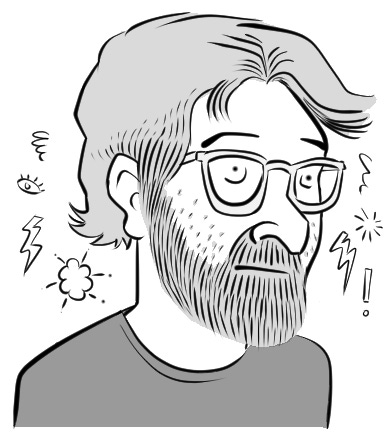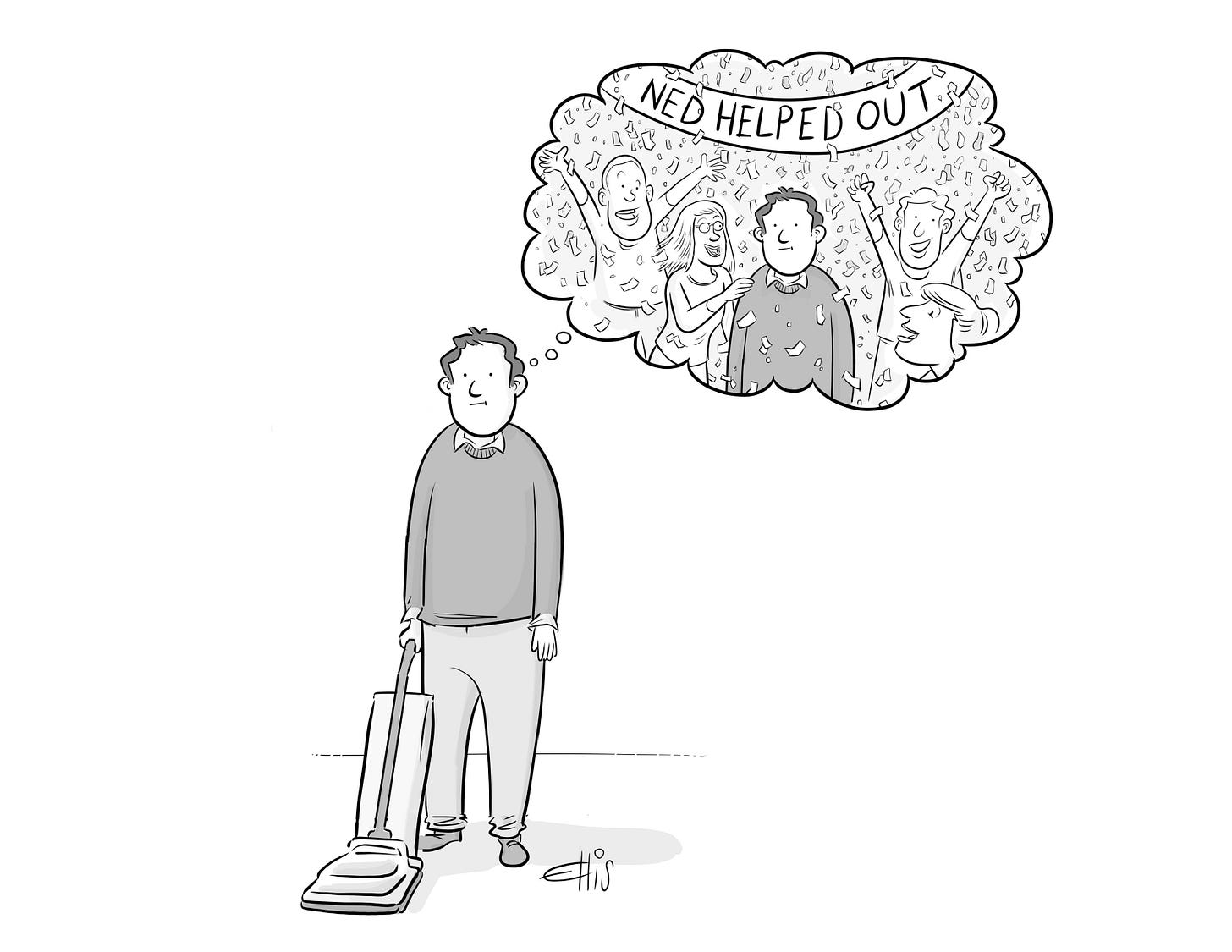CR 053: Cartoonist Ellis Rosen on Finding Humor in the Ordinary
The New Yorker cartoonist discusses his work, his influences, and why cartooning is a numbers game.
Ellis Rosen is a New York-based artist whose work regularly appears in The New Yorker. His one-panel cartoons hilariously mock everyday mundanities, using a simple image and a caption to bring awareness to the ridiculousness of a common thing—a full dishwasher, an overflowing spice rack, our never-ending complaints about the weather. And through his fantastic newsletter, he shares how he came up with some of his more well-known cartoons and answers readers’ questions about his work.
I recently spoke with Rosen over Zoom about his career, his advice for aspiring artists, and why he no longer does political cartoons.
SANDRA EBEJER: Tell me about your background. Do you come from a family of artists?
ELLIS ROSEN: My mother is very creative. She’s not an artist, although she used to make these incredible cakes that were very intricate, and she’s always been a very good drawer. Both my parents are collectors. They like sculpture. They’ve always been encouraging of it. I grew up in lower Manhattan. They bought this place near Tribeca in the ’70s. It was the cool artsy thing to do. So there’s always been an encouragement towards the arts, but neither of them are exactly artists.
Did you draw as a kid?
Always. Yeah, just drawing from the beginning. My brother did it and I tried to jump on board with him. Now he’s a writer. And I was always encouraged in my art classes at school.
I saw that you graduated from the Savannah College of Art and Design. How did you first get into this field professionally?
Even during SCAD it wasn’t really something I thought about. I went to SCAD for sequential art and even there, nobody ever talked about single-panel gag cartoons. It wasn’t until my friend Sam Marlow, who was an animator for a company called Titmouse, and Paul Noth, the cartoonist, were going to do a show. Sam [said to] Paul, “I’ve always wanted to do New Yorker cartoons.” So Paul showed him the ropes. Pretty quickly he sold some cartoons and then was telling me about it. I was like, “Oh my God, that sounds like so much fun.”
At that time, I was trying to figure out what to do, because I didn’t really want to do comics. I wanted to do something with cartooning. Again, it never occurred to me that I could just do these one-off, short, quick things, which I think favors my temperament more so than a long-form thing. I don’t have a lot of focus. I just like to get things over with. I’m also not terribly great with consistency and things like that. So when he started doing it and showing it to me, I was like, “Wow. This is perfect.” I started doing it and immediately was like, “Yeah, this is absolutely what I should be doing.”
Which is not to say I haven’t always loved cartoons. I grew up on the Gary Larson tear-away calendars. And The New Yorker—my parents didn’t subscribe, but if you saw it in a waiting room, that would be the one you picked because it had cartoons in it. Whether or not you understood the cartoon, it was still fun to look at them.
Before COVID, you used to be able to go into The New Yorker on Tuesdays, anyone could, and show your batch of cartoons to the cartoon editor. You’d have a one-on-one [for] 5 to 10 minutes. And when you weren’t doing that, you were in this waiting room with all the other cartoonists. That’s where a community was built. And meeting these people, I mean, they were neurotic in the same way I was. They were funny in the same way I was. So it wasn’t just knowing that this was my medium; this was like, “These are my people.” My closest friends today are all from that place. I would say when you’re an artist and you’re trying to figure out what it is you’re trying to do, what you’re trying to be, finding that community is everything.
Do you draw every day?
I draw a lot. I don’t draw every day. I definitely don’t draw on weekends. I’ve got two tiny children. I write a lot, too. There’s some days where I just write instead of draw. I used to force myself to come up with ideas, but now I don’t do that. If an idea comes, I’ll doodle it. I do something every weekday. I do something in the vicinity of creativity.
Which comes first, the joke or the drawing?
That’s different for every artist. Some people are drawer first versus writing first. I would say I’m definitely writing first. The good ones are the ones where it just comes together, like the caption and the picture come at the exact same time. That’s how you know you really hit on something. You just know it’s coming together in a way that’s going to work. You don’t have to force anything. You know exactly what it’s going to look like. That means something mechanically in the cartoon is already making sense, something underneath that you don’t have to mess around with.
Other cartoons you may have a concept or an idea or a caption even, but you don’t exactly know how it’s going to work yet. That’s most cartoons—for me, anyway. But that usually means that something has to change. You still have to figure something out. Sometimes you could have an idea in your head that you think is great, and then when you translate it down onto paper, it really doesn’t work at all, or sometimes it needs to change quite a bit.
In your newsletter, you shared that with the cartoon “Ned Helped Out,” you used different variations of the caption and discussed them with your editor at The New Yorker in order to determine which version of the cartoon was best. Is it a typical process to create multiples of a cartoon in order to figure out what the joke is?
It certainly happens a lot. It’s not the only cartoon where that’s happened, and that is definitely one way to find a cartoon. And I enjoy that process, because it does feel like a fight. Selling [a cartoon] is not the end-all, but if you do sell it after that fight, it feels really good. It feels like you worked hard for your money in that instance, and it is fun, that creative process.
What was unique about that one is usually that process happens in the sketchbook. With “Ned Helped Out,” I made a bunch of different versions, and I gave them all to the editor. That’s not normal. It’s not abnormal—lots of people have a cartoon with two different captions that are different enough and they’ll put them both in the batch. I’ve done that lots of times. But to give four or five of basically the exact same cartoon, but looking at it from different angles... First of all, I wouldn’t recommend it. It’s not a good way to sell a cartoon. Because at the end of the day, it is a numbers game, and you’ve basically just given one cartoon to the editor. If she likes it, she’s only going to take one. As opposed to, she might take two or three or four if they’re totally different.
What I didn’t talk about is that I actually just did that because every now and then you want to do something weird and crazy just to, I don’t know, reset your brain. And I was just doing that. That was when you could still go in [to The New Yorker]. I knew I could have a conversation with her about it. And she was open to me doing it. She wasn’t dismissive, like, “What are you doing? Don’t waste my time.” [Laughs] That was nice. So that is the story behind “Ned Helped Out,” which is, to this day, my most popular cartoon. So something about that process worked out.
Are you ever surprised by the cartoons that people respond to the most?
Yeah, absolutely. Anytime I post something to Instagram, it’s always a big surprise. Often I’ll think, “This one’s good. It’ll do well.” Nothing. And then sometimes, I’ll be like, “Eh, this one...” and it gets a much better response. I mean, there’s all those algorithmic stuff going on that I can’t [explain], so it’s not just how good or bad a cartoon is. Sometimes I’ll post a cartoon that doesn’t do well and then a year later I post it [again], and it does much better and vice-versa. But in general, yeah, you never really know what’s gonna hit.
I mean, these squirrel cartoons people love—I didn’t even send those to The New Yorker at first. I thought they were just a silly thing for me. I posted them on Instagram, and people seem to like it, so I kept doing more and more. I didn’t think for a second that anyone would really care about those. It’s more frustrating when you’re like, “Oh, this is a good one” and then it doesn’t get any hit at all. That happens a lot.
I’m surprised which one they buy at The New Yorker itself. That’s an inside joke among cartoonists, that they always take the one you least expect. The order of the cartoons doesn’t matter at all. But when I was starting out, these tiny things mattered so much. So I was like, “I’m going to put this weird one at the very end. It’s just a weird one. It’s not going to sell.” I put it at the very end and that’s the one that sold. So, you never know, for the most part.
Given everything that’s going on in the world, is it difficult to still find the humor in things?
It’s hard to imagine time when there wasn’t so much going on. [Laughs] I know what you mean, though. Is it hard to find the humor? I don’t know.
You don’t do a lot of heavily political stuff.
No. I used to. In 2016, ’17, ’18, I used to do a lot, and then I don’t know what happened. I think about it a lot. Something happened. Something broke. [Laughs] And now, I just can’t. I mean, talking political cartoons is a whole long conversation in itself, and I have problems with some forms of it. I sometimes wonder if I’m even the right person that should be talking about this stuff.
Actually commenting on what’s going on, for some reason, is harder for me than ever, and it doesn’t correlate to how much I pay attention. I’m, just like everyone else, constantly looking at the terrible news. [Laughs] I don’t know what changed, but something for me changed, and I wish I had a better answer for you, but I just don’t know myself. I’m still trying to figure out. I used to think it got too depressing or something, but I’m not sure that’s it. Because I was pissed and depressed in 2016, in 2017, 2018 when I was doing them once a week. I mean, I had a daily cartoon all the time. But there was one point where I was drawing [Trump] and I was like, “It feels like I’m making him cute.” Like it’s just a little joke. It almost, in a weird way, helps him, or it’s glib, or it makes the seriousness of it seem less serious. Something like that. And that may be part of it, except I don’t necessarily agree with that when it comes to other people’s cartoons. My friend Lars Kenseth did a great daily yesterday. My friend Brendan Loper, who’s the king of the daily, does them all the time. I don’t have this criticism of their cartoons at all. So I don’t know. When it comes to me making it, I feel like I’m doing more harm than good, or I am taking out the seriousness of it or something.
Who are your influences? Who or what do you turn to when you need inspiration?
Roz Chast, for sure. Reading one of her books will make you want to do it. All my peers in general. If you go to CartoonStock.com, there’s a thing where you can just look at The New Yorker cartoons, and you just scroll through their cartoons. Or you pick an artist—I pick a new one almost every day. I just look through their stuff. It’s fantastic. Gary Larson, of course. Sergio Aragones—he used to do this comic called Groo the Wanderer with a guy named Mark Evanier. I grew up on those comics. I taught myself how to read on those comics. I was taught to read at school, but when it came to just me personally reading, I would have these comics, and I would read the word bubbles that had one word in it first and then I’d slowly work my way up until finally I was reading them all. Mark Evanier’s humor really sculpted mine to a large extent, and I loved Sergio Aragones’s art. I still look at that to feel good about what I’m doing.
What advice do you have for aspiring cartoonists?
It’s a numbers game. It’s an ephemeral art form. It’s really just about making something, moving on, making something, moving on, making something, moving on. And I like that. They say cartoonists are people who can’t really draw and can’t really write. We combine the two. But what I like about cartoon is you don’t have to dwell on this stuff. You don’t have to make a masterpiece. You don’t have to pour your life’s work into one individual thing. It’s a little piece of yourself and so you just keep trucking along.
The biggest surge of my ability to draw came from that first year I was submitting. You’re drawing 10 cartoons every week. I got so much better at drawing. That’s the great thing about this process—a comic requires the script, the storyboards, the art, the penciling, all this stuff. Everything’s changing. Cartoons are just one and done. So I would say the best advice is to just draw them, to not look back. You can look back and come up with a better idea for a similar concept, but especially in the beginning, that doesn’t matter. Just keep doing them and don’t fuss, don’t worry, because most of them are gonna be bad, but 10% of them will be good. If you have a large enough pile of cartoons, I guarantee you’re gonna have some good ones in there, even if you’re terrible at it. You know, the broken clock is right twice [a day]. It’s just a numbers game. So just draw them. You’re going to get better in every aspect.
To learn more about Ellis Rosen, find him on Instagram.
This interview has been edited for clarity and length.
You might also enjoy…










